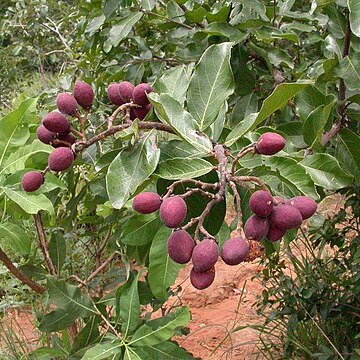Receptacle-tube often slightly curved, obconoidal or subcampanulate, always gradually narrowed into the pedicel, nearly always almost solid and almost completely filled with nectariferous tissue, glabrous inside on one side, hairy on the other, or completely glabrous.
Stamens 20–60; filaments white, inserted in two rows on the free margin of the disk; tightly undulate in bud with 2 or more undulations, much longer than the sepals, usually occurring in a tangled mass; staminodes few and vestigial or absent.
Drupe fleshy; endocarp very hard, fibrous with a rough exterior; glabrous inside, with 2 lateral plates which break away on germination and allow the seedlings to escape.
Ovary of 1 or sometimes 2–3 bilocular carpels, inserted at mouth of receptacle-tube; style curved upwards, much longer than the sepals, glabrous except at base.
Bracts and bracteoles eglandular, caducous, not concealing young flowers.
Lower leaf-surface glabrous or with dense arachnoid indumentum.
Inflorescence a many-flowered corymb or panicle.
Germination epigeal; first leaves opposite.
Petals suborbicular to broadly lingulate.
Sepals suborbicular, deeply concave.
Flowers slightly zygomorphic.
Trees.

